Children's Average Shoe Size by Age UK
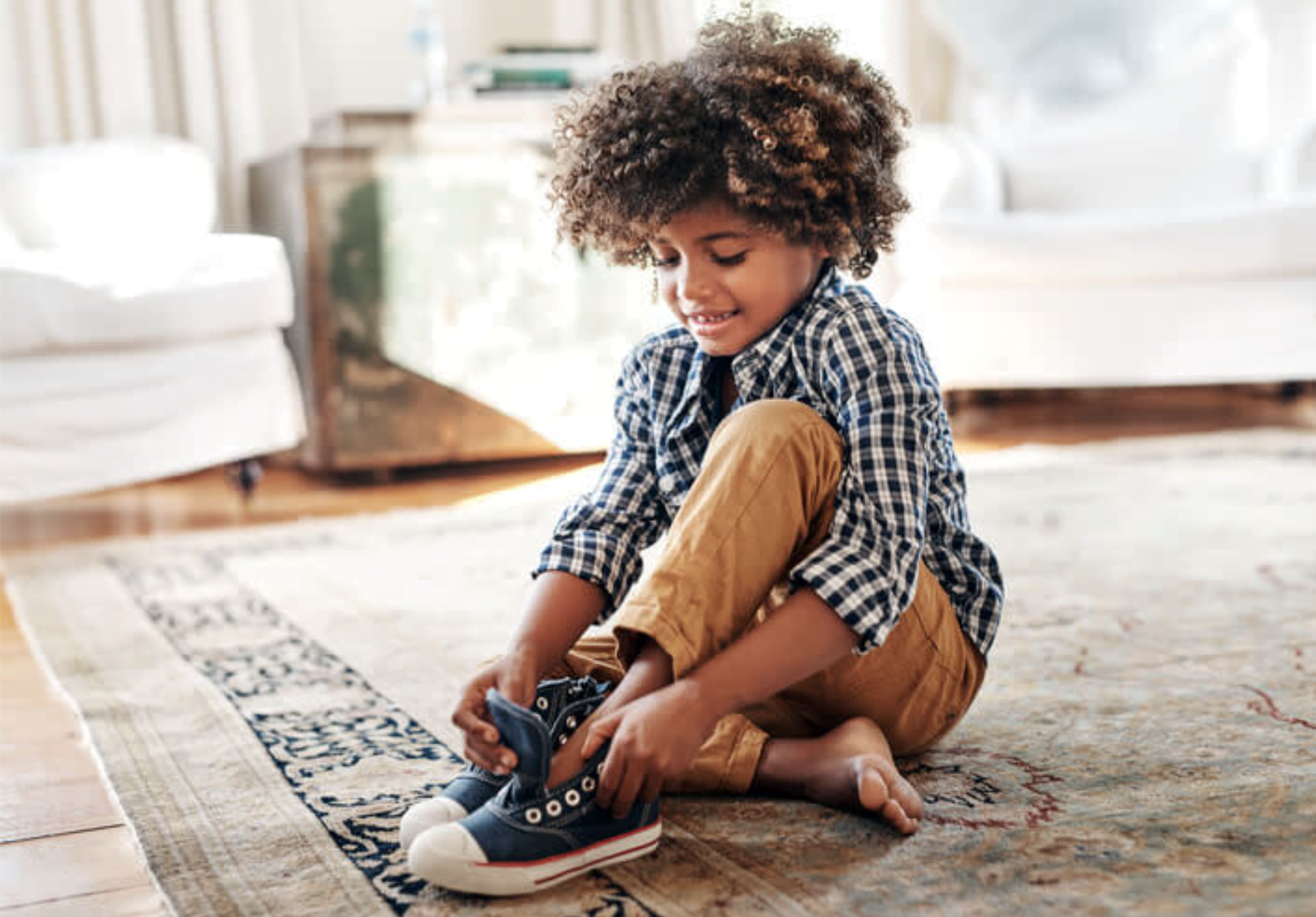
Those first pair of tiny shoes are simply adorable! But it's not long before you start to feel like your children's feet are growing out of a pair every other minute!
In this article we ask paediatric podiatrist Dr Cylie Williams all about little feet! She gives tips on how to measure your little one's feet accurately, what average shoe sizes are by age, and what to consider when shopping for the next perfect pair.
We provide you with a handy guide that includes a shoe size conversion chart and calculator so you'll know which size to buy when shopping whether its for boots, trainers or sandals.
Find all the information you need to ensure your kid's shoes fit correctly to ensure they are comfortable and allow for healthy movement and foot development.
| Age | EU | UK | US |
|---|---|---|---|
| 1 year | 20-21 | 4-4.5 | 5-5.5 |
| 2 year | 22-23 | 5-6 | 6-7 |
| 3 year | 24-25 | 7-8 | 8-9 |
When do kid's need their first pair of shoes?
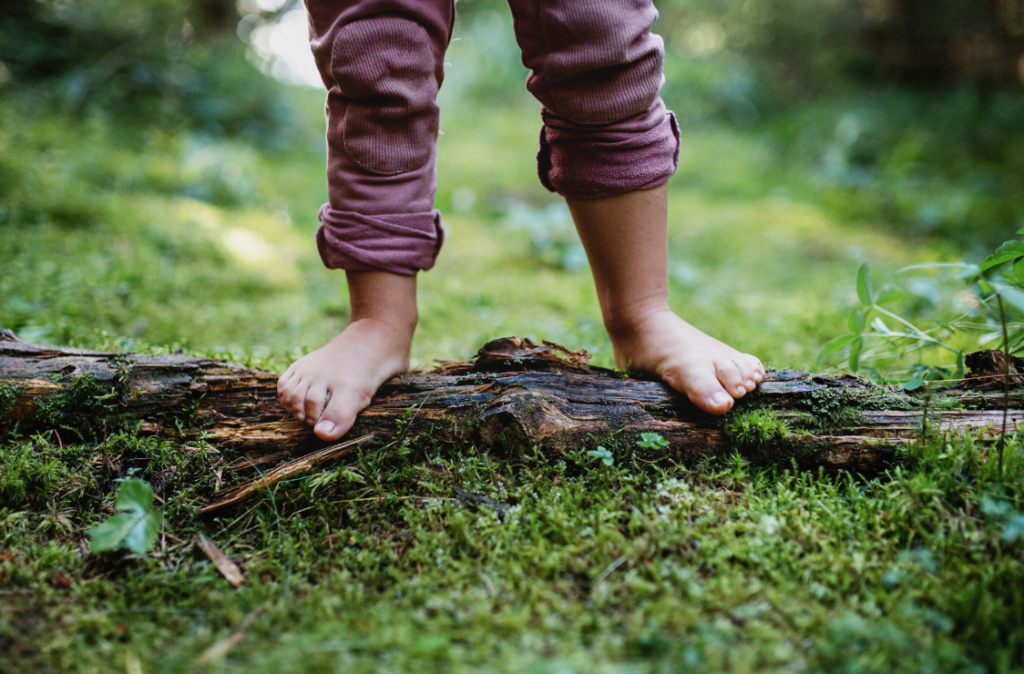
Tiny booties on newborn babies are definitely super cute, but children don't actually need to wear shoes until they are confidently walking barefoot and starting to venture onto surfaces that may be too hot, too cold, or too prickly.
Most children begin walking between 9 and 18 months. Before that, it's best to let your kids explore and develop their balance and coordination without shoes. You'll probably find they take every opportunity to get the damn things off anyway!
Once kids are walking confidently and ready to take those first steps outside, it's then a good idea to invest in a pair of well-fitting shoes to protect their feet and provide support.
Can shoes lead to walking issues in toddlers?
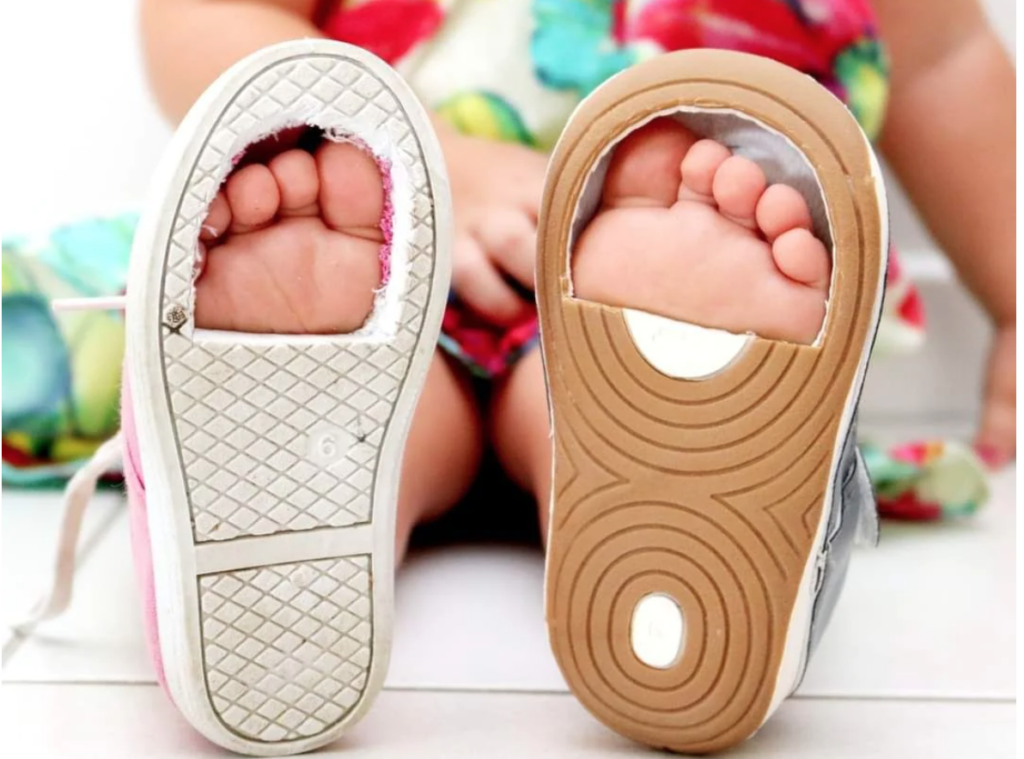
"The truth is until recently we didn't know that much about what actually happens when toddler's wear shoes while learning to walk. We studied this in our foot lab and found that there are subtle changes in how children move their hips, knees and feet when learning to walk wearing footwear versus barefoot.
But these changes are very small and in most cases don't significantly impact foot development or cause delays or problems with walking." explained Dr Williams.
When choosing shoes for toddlers you should select a 'pre walker' or 'first walker' style - these are designed with soft, flexible soles to allow natural foot movement.
Take an accurate measurement of both the foot length and width (see below) to ensure shoes are comfortable and allow the natural spread of the foot when standing and moving.
How to Measure Kids' Feet
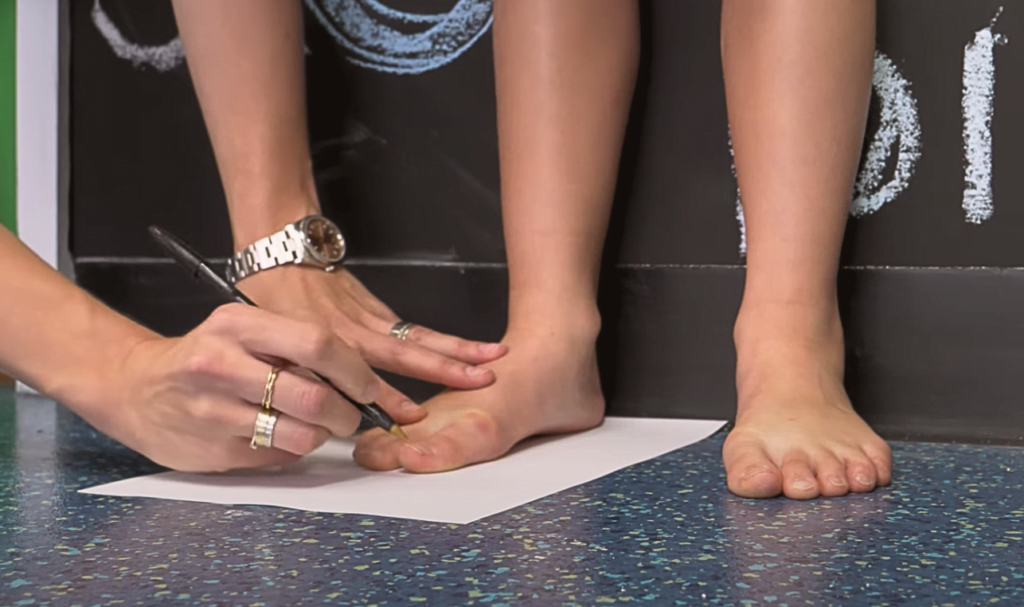
Lots of shoe stores will measure your little one's feet (see examples below). But here's how you can measure your child's feet accurately at home:
1. Use a firm surface
To measure foot length place a tape measure or ruler under or to the side of the foot, record a point from the back of the heel to the tip of the longest toe (usually the big toe). Record the length exactly, no need to add 'room' as shoe sizing accounts for this. Note down the measurement in millimeters (mm).
Place your child's foot on a firm surface like the floor ensuring the feet are relaxed with toes not curled or clenched. Ensure both feet are flat and your child is not leaning to one side. You can place a sheet of paper under the foot to mark with a pen if they're particularly wriggly.
2. Measure length
Tip: measuring with the foot placed against a wall can make it easier to find an accurate length.
3. Measure width (circumference)
Foot width is measured as a circumference (like a ring around your foot). To measure foot width, use a soft tape measure or string. Place it around your child's foot at the widest point, usually where the big toe meets the main part of the foot. Take the measurement with the string flat against the foot all the way round. Note down the measurement in millimeters (mm).
4. Check the chart or calculator below
Refer to the kids' shoe size conversion chart below to find the corresponding size.
Kids' Shoe Size Conversion Chart
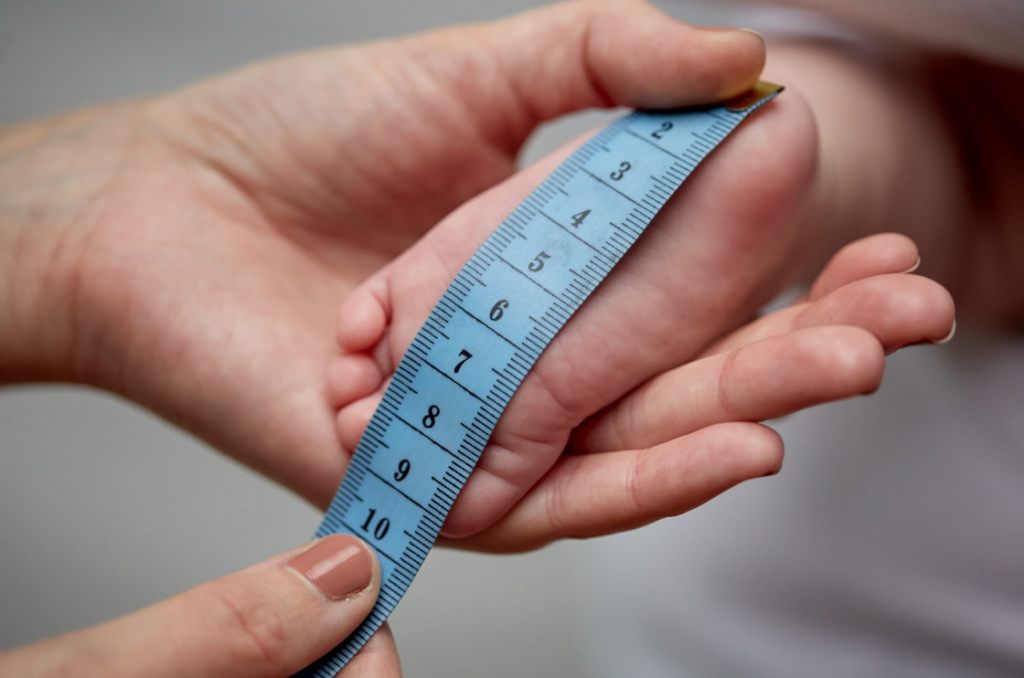
The kids' shoe size chart below shows UK, European and US sizes - make sure to check which size is being quote, especially if you're ordering online!
The chart provides the corresponding sizes for each age range, from infant sizes to junior sizes. To read the chart look down to the foot length column to find the length you measured. This will determine the show size. Next read along to the width measurement to choose which width category (if applicable). I = infant, S/J = small/junior, L/A = large/adult.
| UK Size | EU Size | US Size | Length (mm) | D Fit (mm) | E fit (mm) | F fit (mm) | G fit (mm) | H fit (mm) |
|---|---|---|---|---|---|---|---|---|
| Newborn | 15 | 0 | 82-85 | N/A | N/A | N/A | N/A | N/A |
| I 0 | 16 | 1 | 85-89 | N/A | N/A | N/A | N/A | N/A |
| I 1 | 17 | 2 | 90-93 | N/A | N/A | N/A | N/A | N/A |
| S/J 2 | 18 | 3 | 94-103 | 119-124 | 125-130 | 131-137 | 138-143 | 144-149 |
| S/J 2.5 | 18 | 3.5 | 104-107 | 121- 26 | 127-133 | 134-139 | 140-145 | 146-152 |
| S/J 3 | 19 | 4 | 108-111 | 123-129 | 130-135 | 136-141 | 142-148 | 149-154 |
| S/J 3.5 | 20 | 4.5 | 112-116 | 126-131 | 132-137 | 138-144 | 145-150 | 151-157 |
| S/J 4 | 20 | 5 | 117-120 | 128-133 | 134-140 | 141-146 | 147-153 | 154-159 |
| S/J 4.5 | 21 | 5.5 | 121-124 | 131-136 | 137-142 | 143-149 | 150-155 | 156-161 |
| S/J 5 | 22 | 6 | 125-128 | 133-138 | 139-145 | 146-151 | 152-157 | 158-164 |
| S/J 5.5 | 22 | 6.5 | 129-133 | 135-141 | 142-147 | 148-153 | 154-160 | 161-166 |
| S/J 6 | 23 | 7 | 134-137 | 138-143 | 144-149 | 150-156 | 157-162 | 163-168 |
| S/J 6.5 | 24 | 7.5 | 138-141 | 140-145 | 146-152 | 153-158 | 159-164 | 165-171 |
| S/J 7 | 24 | 8 | 142-145 | 142-148 | 149-154 | 155-160 | 161-167 | 168-173 |
| S/J 7.5 | 25 | 8.5 | 146-150 | 145 - 150 | 151-157 | 158-163 | 164-169 | 170-176 |
| S/J 8 | 25 | 9 | 151-154 | 147-153 | 154-159 | 160-165 | 166-172 | 173-178 |
| S/J 8.5 | 26 | 9.5 | 155-158 | 150-!55 | 156-161 | 162-168 | 169-174 | 175-180 |
| S/J 9 | 27 | 10 | 159-162 | 155-160 | 161-167 | 168-173 | 174-179 | 180-186 |
| S/J 9.5 | 27 | 10.5 | 163-166 | 157-163 | 164-169 | 170-175 | 176-182 | 183-188 |
| S/J 10 | 28 | 11 | 167-170 | 160-165 | 166-171 | 172-178 | 179-184 | 185-190 |
| S/J 10.5 | 29 | 11.5 | 171-175 | 162-167 | 168-174 | 175-180 | 181-186 | 187-193 |
| S/J 11 | 29 | 11.5 | 176-179 | 164-170 | 171-176 | 177-183 | 184-189 | 190-195 |
| S/J 11.5 | 30 | 12.5 | 180-183 | 167-172 | 173-179 | 180-185 | 186-191 | 192-198 |
| S/J 12 | 31 | 13 | 184-187 | 169-175 | 176-181 | 182-187 | 188-194 | 195-200 |
| S/J 12.5 | 31 | 13.5 | 188-192 | 172-177 | 178-183 | 184-190 | 191-196 | 197-202 |
| S/J 13 | 32 | 1 | 193-196 | 174-179 | 180-186 | 187-192 | 193-198 | 199-205 |
| S/J 13.5 | 32 | 1.5 | 197-200 | 176-182 | 183-188 | 189-194 | 195-201 | 202-207 |
| L/A 1 | 33 | 2 | 201-204 | 179-184 | 185-190 | 191-197 | 198-203 | 204-210 |
| L/A 1.5 | 34 | 2.5 | 205-209 | 181-186 | 187-193 | 194-199 | 200-206 | 207-212 |
| L/A 2 | 34 | 3 | 210-213 | 182-188 | 189-194 | 195-200 | 201-207 | 208-213 |
| L/A 2.5 | 35 | 3.5 | 214-217 | 185-191 | 192-197 | 198-203 | 204-210 | 211-216 |
| L/A 3 | 36 | 4 | 218-221 | 189-194 | 194-200 | 201-207 | 208-213 | 214-219 |
| L/A 3.5 | 36 | 4.5 | 222-225 | 192-197 | 198-203 | 204-210 | 211-216 | 217-222 |
| L/A 4 | 37 | 5 | 226-230 | 195-200 | 201-207 | 208-213 | 214-219 | 220-226 |
| L/A 4.5 | 38 | 5.5 | 231-234 | 198-203 | 204-210 | 211-216 | 217-222 | 223-229 |
| L/A 5 | 38 | 6 | 235 -238 | 201-207 | 208-213 | 214-219 | 220-226 | 227-232 |
| L/A 5.5 | 39 | 6.5 | 239-242 | 204-210 | 211-216 | 217-222 | 223-229 | 230-235 |
| L/A 6 | 39 | 7 | 243-247 | 208-213 | 214-219 | 220-226 | 227-232 | 233-238 |
D Fit = 'extra narrow'; E fit = 'narrow'; F fit = 'standard'; G fit = 'wide'; H fit = 'extra wide'
Foot Size Calculator
You can also use this helpful size calculator by Start-Rite to help convert your measurements into your child's shoe size. They have a printable paper measure too, which can make getting the right measurements a little easier too!
Which shops offer a free kids shoe size measuring service?
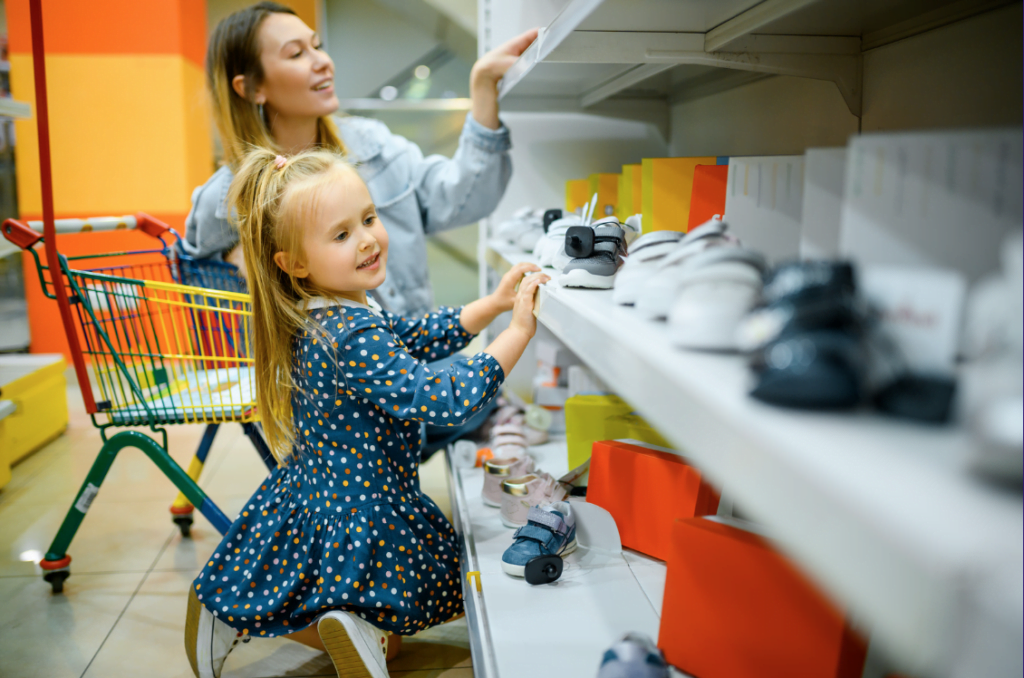
Of course you can always opt to leave the measuring to the professionals! A number of stores offer foot measurement and shoe recommendation services for kids. Clarks, Marks & Spencers and John Lewis all offer free foot measurement. And FYI you're not under any obligation to buy their shoes!
It's a good idea to book an appointment to avoid disappointment especially during busy periods like before the school term starts! Make bookings using the links to each retailer above.
Average Age Show Size
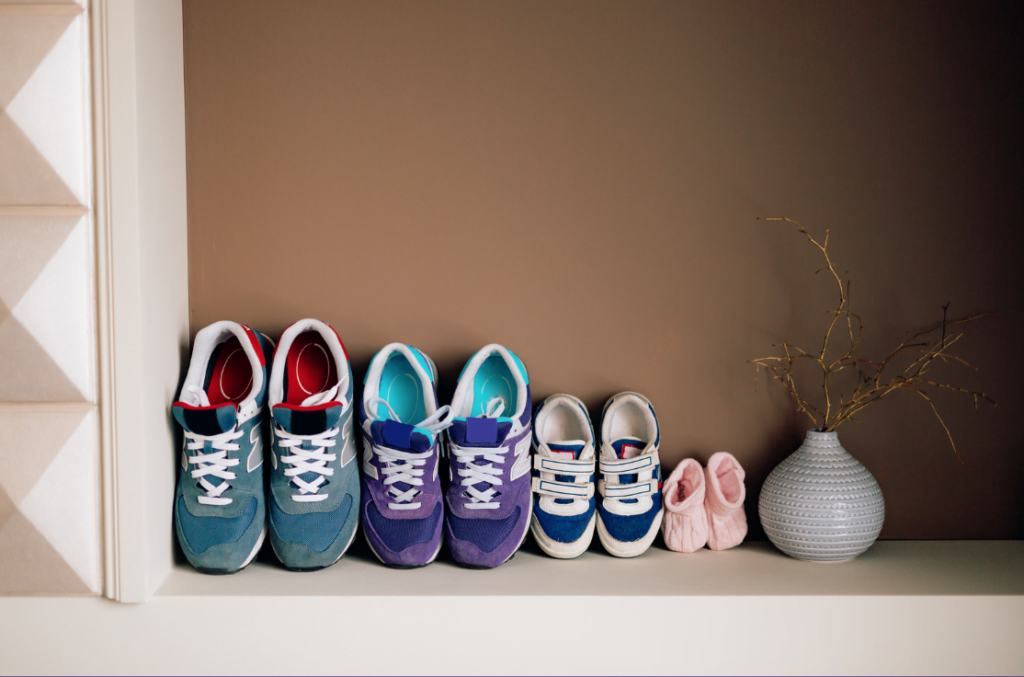
"When it comes to feet each child's are as unique as the rest of them!" explains Dr Williams. But it can still be useful to have an idea of what's typical - the average shoe size guide chart gives you an idea of average shoe sizes based on age. Use it to compare with your little one's measurements.
| Age | UK | EU | US |
|---|---|---|---|
| Birth | 'Newborn | 15 | 0 |
| 0-3 month | 0 | 16 | 1 |
| 3-6 month | 1 | 17 | 2 |
| 6-9 month | 2 | 18 | 3 |
| 9-12 month | 3 | 19 | 4 |
| 1 year | 4-4.5 | 20-21 | 5-5.5 |
| 2 year | 5-6 | 22-23 | 6-7 |
| 3 year | 7-8 | 24-25 | 8-9 |
| 4 year | 8.5-9 | 26-27 | 9.5 -10 |
| 5 year | 10-10.5 | 28-29 | 11-11.5 |
| 6 year | 11.5 | 30 | 12.5 |
| 7 year | 12.5 | 31 | 13.5 |
| 8 year | 13 | 32 | 1 |
| 9 year | 1 | 33 | 2 |
| 10 year | 2 | 34 | 3 |
| 11 year | 2.5 | 35 | 3.5 |
| 12+ years | 3 | 36 | 4 |
| 12+ years | 4 | 37 | 5 |
| 12+ years | 5 | 38 | 6 |
| 12+ years | 6 | 39 | 7 |
| 12+ years | 7 | 40 | 8 |
How often should children's feet be remeasured?

Babies and children's feet grow at different rates and change regularly. Dr Williams suggested remeasuring every 3-4 months in the early years to avoid leaving them in shoes that are on the small side and squashing those little toes!
It's important to ensure the width of a shoe is correct even if there hasn't been much obvious increase in length. Many toddlers have relatively wide feet compared to older children and adults.
Is there a difference in average shoe size for girls and boys?

Research suggests that boys and girls have similar average shoe sizes during their early childhood years. Until around the age of 10, their feet tend to grow at a similar rate. However, as they approach puberty, which usually starts around the ages of 9 to 13, there may be some variations in foot size due to hormonal changes and growth spurts.
During puberty, boys' feet usually continue to grow, while girls' feet tend to stop growing earlier. Even with these considerations in mind it's important to note that there's lots of variation, and not all children follow the same growth patterns.
When do children's feet stop growing?
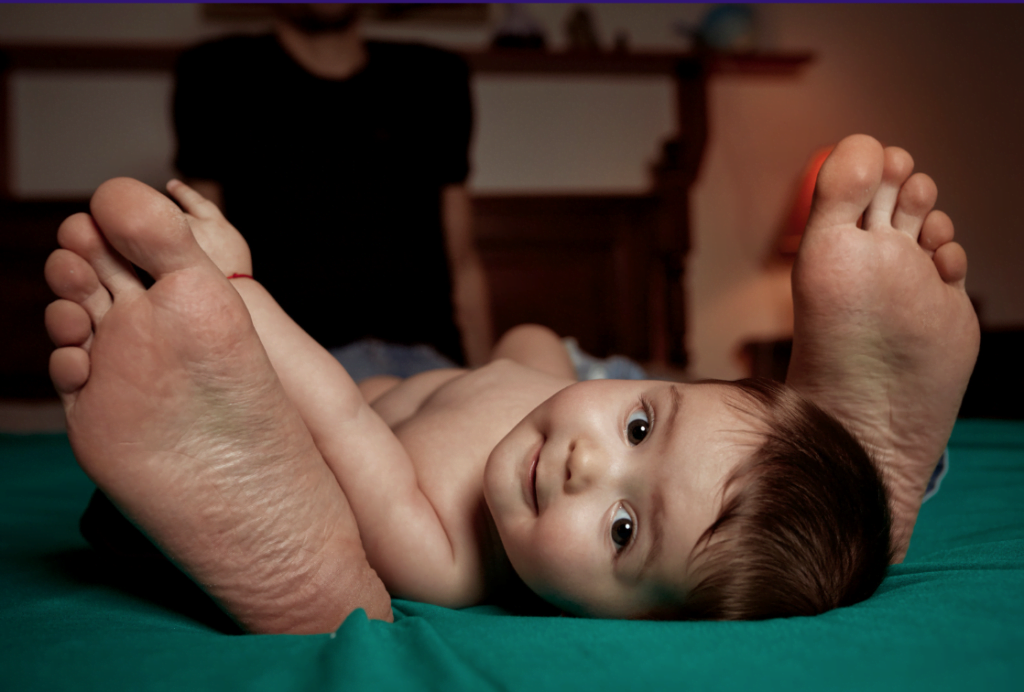
As a rule of thumb, girls' feet tend to stop growing around the ages of 13 to 15 years, while boys' feet might continue growing until about 15 to 17. However, these are just general ranges, and individual variations are common.
Does my child need to see a Podiatrist?
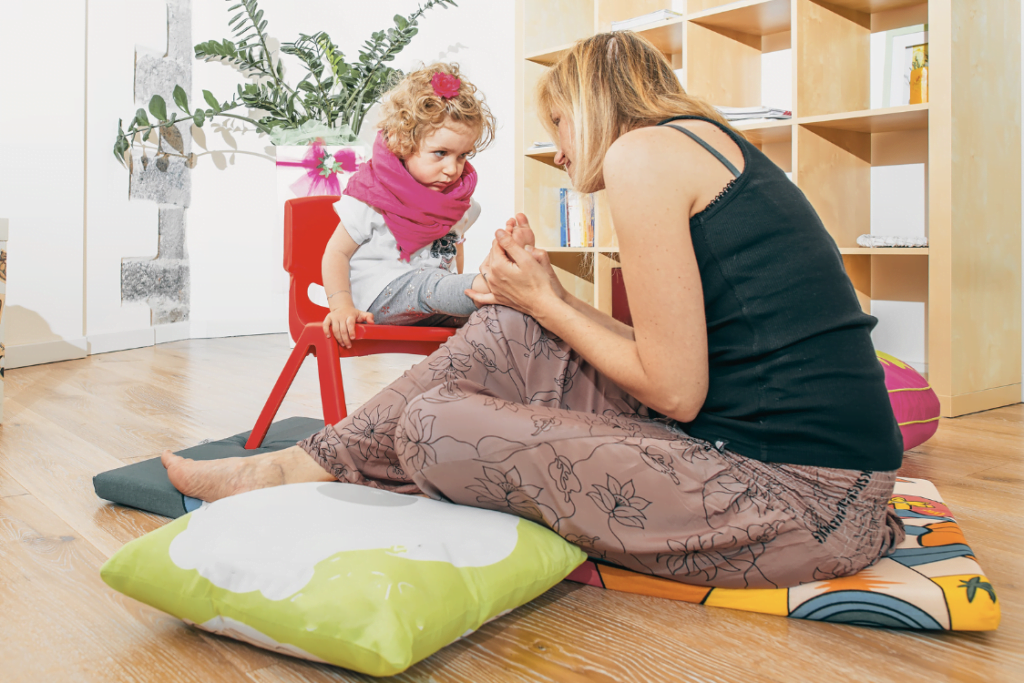
Podiatrists like Dr Williams see lots of children with common foot problems. For example, if your child walks on their tip-toes a lot, or if they have flat feet or really high arches, it's a good idea to see a specialist.
Other reasons you might want to see a podiatrists are if your child complains of frequent foot or leg pain, or if they have ingrown toenails, warts, or other skin issues on their feet, it's best to get it looked at.
Sometimes, kids may walk with their feet turning in or out, which can be a sign of something not quite right.
Finally if your child plays sports and gets foot injuries, it's a good idea to get them checked out too. A podiatrist is a good place to start if you think it might be a mild injury.
Seeing a podiatrist early can allow them to make suggestions about shoes and other supports which can help prevent any foot problems from getting worse and keep your child's feet healthy as they grow. And they'll be able to make a referral to your doctor or a physiotherapist if they have concerns.
Take Homes
In this article, we've covered essential tips to promote the healthy development of your child's feet. Letting them go barefoot as they explore and play can strengthen foot muscles and improve balance. When it's time for shoes, opt for 'pre-walker' or 'first walker' styles with soft, flexible soles to allow natural foot movement. Remember to measure your child's feet regularly to ensure they're wearing comfortable and properly sized shoes.
Using the kids' shoe size conversion chart provided, you can find the right size for your child's age range. As their feet grow rapidly, it's crucial to remeasure every 3-4 months to accommodate growth and avoid squashing little toes in too-small shoes.
By following these guidelines, you can help ensure your child's feet develop healthily and comfortably. For more information on children's health and wellbeing and to join our community of families and caregivers here and register on the waitlist today!

